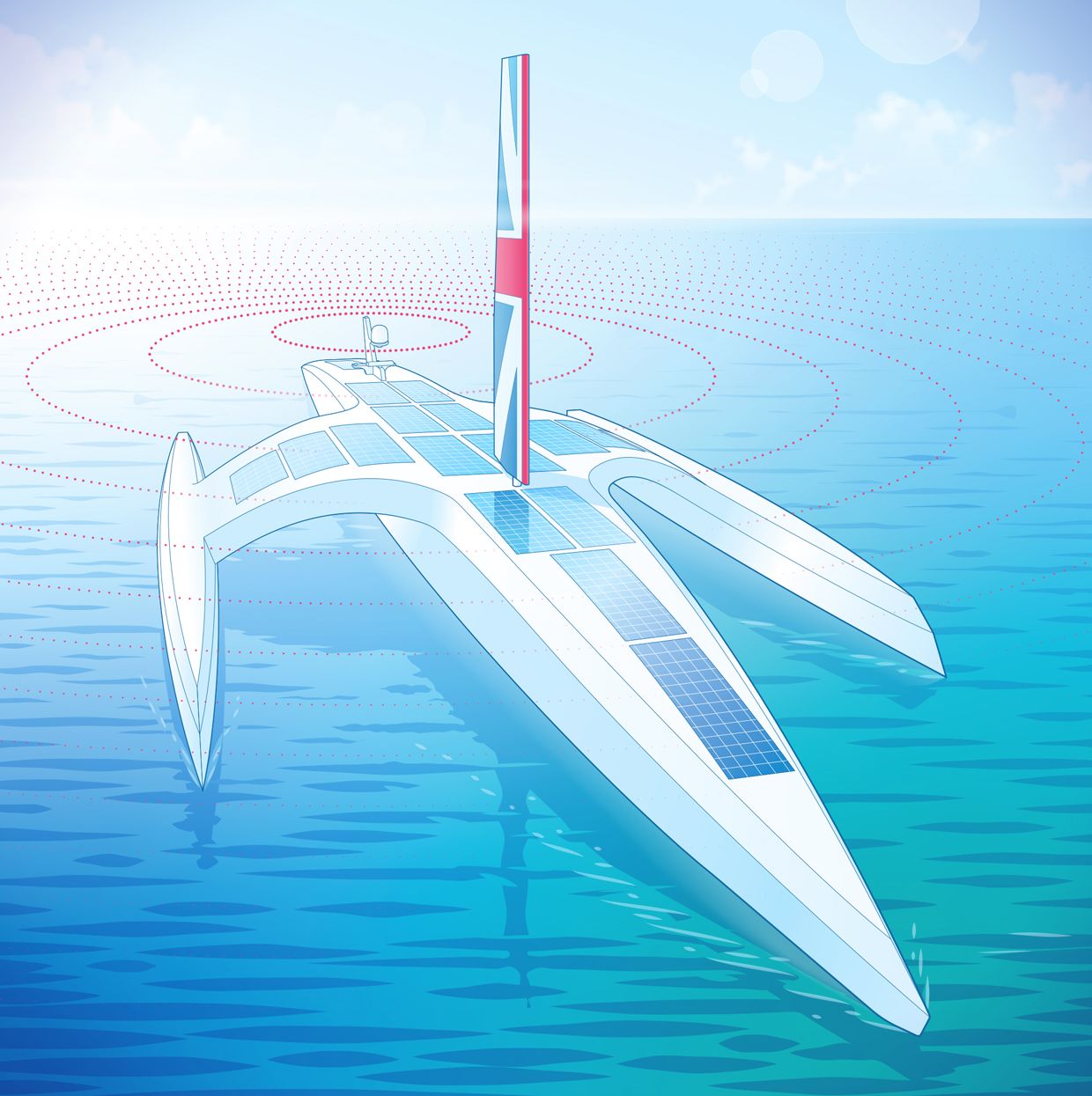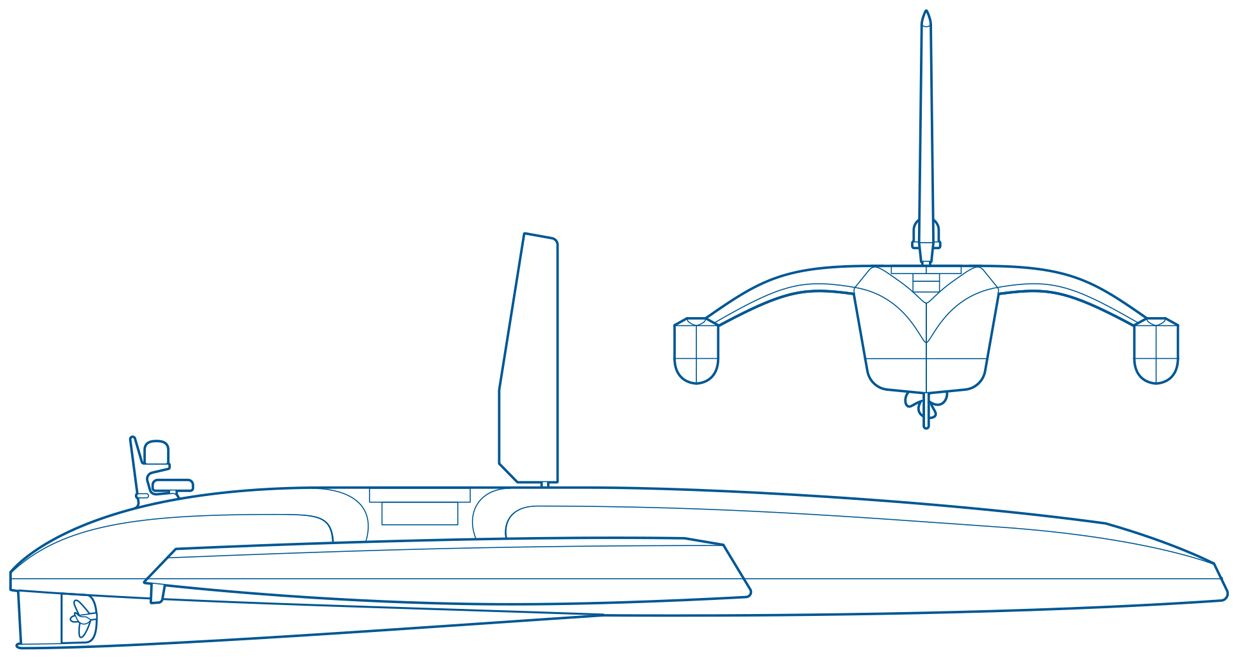Bon Voyage for the Autonomous Ship Mayflower
 Illustration: James Provost Because it has neither pilgrims nor crew, this boat can put solar panels where the deck would be-and sensors way in the back.
Illustration: James Provost Because it has neither pilgrims nor crew, this boat can put solar panels where the deck would be-and sensors way in the back. 
In September a modern-day Mayflower will launch from Plymouth, a seaside town on the English Channel. And as its namesake did precisely 400 years earlier, this boat will set a course for the other side of the Atlantic.
Weather permitting, the 2020 voyage will follow the same course, but that's about the only thing the two ships will have in common. Instead of carrying pilgrims intent on beginning a new life in the New World, this ship will be fully autonomous, with no crew or passengers on board. It will be powered in part by solar panels and a wind turbine at its stern. The boat has a backup electrical generator on board, although there are no plans to refuel the boat at sea if the generator backup runs dry.
The ship will cross the Atlantic to Plymouth, Mass., in 12 days instead of the 60 days of the 1620 voyage. It'll be made of aluminum and composite materials. And it will measure 15 meters and weigh 5 metric tons-half as long and 1/36 as heavy as the original wooden boat. Just as a spacefaring mission would, the new Mayflower will contain science bays for experiments to measure oceanographic, climate, and meteorological data. And its trimaran design makes it look a little like a sleek, scaled-down, seagoing version of the Battlestar Galactica, from the TV series of the same name.
"It doesn't conform to any specific class, regulations, or rules," says Rachel Nicholls-Lee, the naval architect designing the boat. But because the International Organization for Standardization has a set of standards for oceangoing vessels under 24 meters in length, Nicholls-Lee is designing the boat as close to those specs as she can. Of course, without anyone on board, the new Mayflower also sets some of its own standards, too. For instance, the tightly waterproofed interior will barely have room for a human to crawl around in and to access its computer servers.
"It's the best access we can have, really," says Nicholls-Lee. "There won't be room for people. So it is cozy. It's doable, but it's not somewhere you'd want to spend much time." She adds that there's just one meter between the waterline and the top of the boat's hull. Atop the hull will also be a "sail fin" that juts up vertically to exploit wind power for propulsion, while a vertical turbine exploits it to generate electricity.
Nicholls-Lee's architectural firm, Whiskerstay, based in Cornwall, England, provides the nautical design expertise for a team that also includes the project's cofounders, Greg Cook and Brett Phaneuf. Cook (based in Chester, Conn.) and Phaneuf (based in Plymouth, England) jointly head up the marine exploration nonprofit Promare.
 Illustration: James Provost The course the Pilgrims took is about the only thing the two ships will have in common.
Illustration: James Provost The course the Pilgrims took is about the only thing the two ships will have in common. Phaneuf, who's also the managing director of the Plymouth-based submersibles consulting company MSubs, says the idea for the autonomous Mayflower quadricentennial voyage came up at a Plymouth city council meeting in 2016. With the 400th anniversary of the original voyage fast approaching, Phaneuf said Plymouth city councillors were chatting about ideas for commemorating the historical event.
"Someone said, 'We're thinking about building a replica,' " Phaneuf says. "[I said], 'That's not the best idea. There's already a replica in Massachusetts, and I grew up not far from it and Plymouth Rock.' Instead of building something that is a 17th-century ship, we should build something that represents what the marine enterprise for the next 400 years is going to look like." The town's officials liked the idea, and they gave him the resources to start working on it.
The No. 1 challenge was clear from the start: "How do you get a ship across the ocean without sinking?" Phaneuf says. "The big issue isn't automation, because automation is all around us in our daily lives. Much of the modern world is automated-people just don't realize it. Reliability at sea is really the big challenge."
But the team's budget constrained its ability to tackle the reliability problem head-on. The ship will be at sea on its own with no crewed vessel tailing it. In fact, its designers are assuming that much of the Atlantic crossing will have to be done with spotty satellite communications at best.
Phaneuf says that the new Mayflower will have little competition in the autonomous sailing ship category. "There are lots of automated boats, ranging in size from less than one meter to about 10 meters," he says. "But are they ships? Are they fully autonomous? Not really." Not that the team's Mayflower is going to be vastly larger than 10 meters in length. "We only have enough money to build a boat that's 15 meters long," he says. "Not big, by the ocean's standards. And even if it was as big as an aircraft carrier, there's a few of them at the bottom of the ocean from the years gone by."
Cook, who consults with Phaneuf and the Mayflower project from a distance in his Connecticut office, says the 400-year-anniversary deadline was always on researchers' minds.
"There are a lot of days when you think we'll never get this done," Cook says. "And you just keep your head down and power through it. You go over it, you go under it, you go around it, or you go through it. Because you've got to get it. And we will."
When IEEE Spectrum contacted Cook in October, he was negotiating with the shipyard in GdaAsk, Poland, that's building the new Mayflower's hull. The yard needed plans executed to a level of detail that the team was not quite ready to provide. But parts of the boat needed to be completed promptly, so the day's balancing act was already under way.
The next day's challenge, Cook says, involved the output from the radar systems on the boat. The finest commercial radars in the world, he says, are worthless if they can't output raw radar data-which the computers on the ship will need to process. So finding a radar system that represents the best mix of quality, affordability, and versatility with respect to output was another struggle.
Nicholls-Lee specializes in designing sustainable energy systems for boats, so she was up to the challenge of developing a boat that one day might not need to refuel. The ship will have 15 solar panels, each just 3 millimeters thick, which means they'll follow the curve of the hull. "They're very low profile; they're not going to get washed off or anything like that," Nicholls-Lee says. On a clear day, the panels could potentially generate some 2.5 kilowatts.
 Illustration: James Provost The doubleoutrigger trimaran design recalls that of the spaceship in the "Battlestar Galactica" television series.
Illustration: James Provost The doubleoutrigger trimaran design recalls that of the spaceship in the "Battlestar Galactica" television series. The sail fin is expected to propel the boat to its currently projected average cruising speed of 10 knots. When it operates just on electricity-to be stored in a half-ton battery bank in the hull-the Mayflower should make from 4 to 5 knots.
The ship's eyes and ears sit near the stern, Nicholls-Lee says. Radar, cameras, lights, antennas, satellite-navigation equipment, and sonar pods will all be perched above the hull on a specially outfitted mast.
Nicholls-Lee says she's been negotiating "with the AI team, who want the mast with all the equipment on it as high up as possible." The mast really can't be placed further forward on the boat, she says, because anything that's closer to the bow gets the worst of the waves and the weather. And although the boat could keep moving if its sail fin snapped off, the loss of the mast would leave the Mayflower unable to navigate, leaving it more or less dead in the water.
The problem with putting the sensors behind the sail fin, Nicholls-Lee says, is that it means losing a fair portion of the field of view. That's a trade-off the engineers are willing to work with if it helps to reduce their chances of being demasted by a particularly nasty wave or swell. In the worst case, in which the sail fin gets stuck in one position, blocking the radar, sonar, and cameras, the fin has an emergency clutch. Resorting to that clutch would deprive the ship of the wind's propulsive power, but at least it wouldn't blind the ship.
Behind all that hardware is the software, which of course ultimately does the piloting. IBM supplies the AI package, together with cloud computing power.
The 8 to 10 core team members are now adapting the hardware and software to the problem of transatlantic navigation, Phaneuf says. An example of what they're tweaking is an element of the Mayflower's software stack called the operational decision manager.
"It's a thing that parses rules," Phaneuf says. "It's used in fiscal markets. It looks at bank swaps or credit card applications, making tens of thousands or millions of decisions, over and over again, all day. You put in a set of rules textually, and it keeps refining as you give it more input. So in this case we can put in all the collision regulations and all sorts of exceptions and alternative hypotheses that take into account when people don't follow the rules."
Eric Aquaronne, a cloud-and-AI strategist for IBM in Nice, France, says that ultimately the Mayflower's software must output a perhaps deceptively simple set of decisions. "In the end, it has to decide, Do I go right, left, or change my speed?" Aquaronne says.
Yet within those options, at every instant during the boat's voyage are hidden a whole universe of weather, sensor, and regulatory data, as well as communications with the IBM systems onshore that continue to train the AI algorithms. (The boat will sometimes lose the satellite connection, Phaneuf notes, at which point it is really on its own, running its AI inference algorithms locally.)
Today very little weather data is collected from the ocean's surface, Phaneuf notes. A successful Mayflower voyage that gathered such data for months on end could therefore make a strong case for having more such autonomous ships out in the ocean.
"We can help refine weather models, and if you have more of these things out on the ocean, you could make weather prediction ever more resolute," he says. But, he adds, "it's the first voyage. So we're trying not to go too crazy. I'm really just worried about getting across. I'm letting the other guys worry about the science packages. I'm mostly concerned with the 'not sinking' part now-and the 'get there relatively close to where it's supposed to be' part. After that, the sky's the limit."